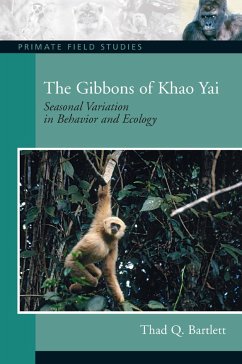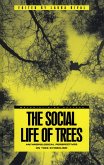Part of Prentice Hall's Primate Field Studies series.
This account of a nine year project on the behavior and ecology of chimpanzees and mountain gorillas living in the same African forest will help students see the way in which a project is planned and put into action as well as the result. This field study is intended to introduce students to the habitat, behavior and social organization, of the the Gibbons of Khao Yai.
Product Description
Primatologists have long viewed small fruiting trees, like figs, as the reason for gibbons' territorial and monogamous behavior. However, at Khao Yai National Park in Thailand where gibbons are prevalent, figs are one of the largest trees in the forest. In this long-term field study, Bartlett addresses this apparent contradiction and follows gibbons as their major food sources fluctuate over time.
The titles in the Primate Field Studies series impart the comprehensive results of long-term field studies to a broad audience at a critical time. Long-term field studies often have a cohesive story to tell which encompasses many different topics, from group size and food distribution, to social behavior, reproduction, and demography. The comprehensive and accessible monographs can supplement textbooks, or may be used as a stand-alone text in upper-level primatology courses.
Features + Benefits
An important reference on gibbons and the study of small apes. Provides an essential resource for students conducting research in this field.
An "all-in-one" source-Serves as an example to students of what a field study on wild primates entails, in its methods, its scope, and its relationship to primatology as a whole.
A historical overview of the study of gibbons in primatology puts this fieldwork in context.
Thorough, expansive coverage of the relationship between fruit abundance and diet, range use, and intergroup interactions in Gibbon apes.
Brief Table of Contents
1 History of Gibbon Field Studies: Monogamy, Frugivory and Territoriality
2 Study Animals, Study Site and Methods
3 Activity Budgets and Social Behavior
4 Diet and Feeding Behavior
5 Ranging Behavior
6 Territoriality and Intergroup Encounters
7 Gibbon Socioecology
8 Summary and Directions for Future Research
References Cited
Index
This account of a nine year project on the behavior and ecology of chimpanzees and mountain gorillas living in the same African forest will help students see the way in which a project is planned and put into action as well as the result. This field study is intended to introduce students to the habitat, behavior and social organization, of the the Gibbons of Khao Yai.
Product Description
Primatologists have long viewed small fruiting trees, like figs, as the reason for gibbons' territorial and monogamous behavior. However, at Khao Yai National Park in Thailand where gibbons are prevalent, figs are one of the largest trees in the forest. In this long-term field study, Bartlett addresses this apparent contradiction and follows gibbons as their major food sources fluctuate over time.
The titles in the Primate Field Studies series impart the comprehensive results of long-term field studies to a broad audience at a critical time. Long-term field studies often have a cohesive story to tell which encompasses many different topics, from group size and food distribution, to social behavior, reproduction, and demography. The comprehensive and accessible monographs can supplement textbooks, or may be used as a stand-alone text in upper-level primatology courses.
Features + Benefits
An important reference on gibbons and the study of small apes. Provides an essential resource for students conducting research in this field.
An "all-in-one" source-Serves as an example to students of what a field study on wild primates entails, in its methods, its scope, and its relationship to primatology as a whole.
A historical overview of the study of gibbons in primatology puts this fieldwork in context.
Thorough, expansive coverage of the relationship between fruit abundance and diet, range use, and intergroup interactions in Gibbon apes.
Brief Table of Contents
1 History of Gibbon Field Studies: Monogamy, Frugivory and Territoriality
2 Study Animals, Study Site and Methods
3 Activity Budgets and Social Behavior
4 Diet and Feeding Behavior
5 Ranging Behavior
6 Territoriality and Intergroup Encounters
7 Gibbon Socioecology
8 Summary and Directions for Future Research
References Cited
Index








